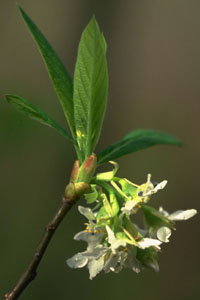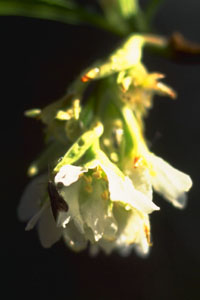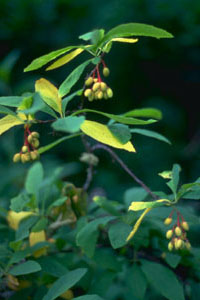| WEEK 1 | WEEKS 2 - 5 | WEEK 6 | WEEK 7 |
WEEK 1: Population Genetics
Simulation software
|
PopG program
|
Single-locus, two allele model that can simulate multiple populations and show effects of mutation, population size (genetic drift), natural selection, and gene flow. |
|
PopBio program
|
Five simulation options including a population genetics module that simulates a single-locus, two allele model. Model parameters include both population size (genetic drift) and natural selection. The program can accumulate a data matrix containing the outcome from multiple replicate runs of a single parameter set. Authored by Reed College faculty, staff and students. |
|
JMP (latest version)
|
Link to Reed's software download site where you can acquire a Reed site-licensed version of JMP (only valid with the associated JMP.per file). Available in versions for both MacOS or Windows. |
|
Bio Binder files
|
Link to Bio 101/102 Bio Binder files on the Biology Resources shared google drive, inside a BioBinder folder in the root folder. The file "3 Quantitative (Sec. E,F,G,H,I,J) 2020.pdf" includes the sections describing statistics and the steps involved in completing anayses using JMP. |
|
A Sesame Street Guide to Taxonomy |
With apologies to anyone who holds the copyrights, here is a 1969 Sesame Street segment with the song "One of these things is not like the other" and a second version featuring Cookie Monster. |
WEEK 2: Introduction to Plant Taxonomy
PLANT TAXONOMY
Several of the professional societies organized for plant taxonomists and systematists now have web pages.The International Association of Plant Taxonomists publishes the journal Taxon and sponsors a number of research projects in plant taxonomy. The IAPT web-site provides on-line access to the International Code of Botanical Nomenclature which was adopted at the 18th International Botanical Congress held in 2011 in Melbourne, Australia.
The American Society of Plant Taxonomists publishes the journal Systematic Botany. Their web-site includes information about the society, its annual meeting, the journal Systematic Botany (and a membership directory that can be queried by member's Research Interests.
The International Plant Names Index is a database with bibliographic references for more than 1.3 million species of plants.
The Checklist of the Vascular Plants of the Americas contains an integrated assessment of all known native species of vascular plants in the New World.
An on-line Glossary of Roots of Botanical Names is available that will provide the meanings of many of the Latin and Greek words that serve as the roots of botanical scientific names.
If singing helps you to learn, be sure to listen to "What Are The Parts Of A Flower" (find it on YouTube). You can try seaching on "Singing Science Records" to find more of the informative nature songs (the former site exists only at the Internet Archives "Way Back Machine").
HERBARIA
Plant herbaria provide researchers with access to important collections of preserved plant materials and serve as institutional centers for much of the research conducted in plant taxonomy and systematics. To read about some of the important functions provided by herbaria, consult the short FAQ available from the UC Berkeley Herbarium, entitled "What are all those dead plants for, anyway? ". Below are links to several important herbaria that have information available at their sites on the internet. Many of these institutions now support on-line access to their databases. The first two (OSU. and UC Berkeley) are important west coast institutions, while the other three (Missouri Botanical Garden, NY Botanical Garden, and RBG at Kew) are internationally renowned centers for research in plant systematics and taxonomy.The importance of herbarium research to Darwin's developmnet as a scientist is recounted in a recent article: "What Henslow taught Darwin: how a herbarium helped to lay the foundations of evolutionary thinking" (Kohn et al., 2005; Nature 436: 643-645).
A listing of the world's herbaria can be found in the New York Botanic Garden's Index Herbariorum.
| Reed College Herbarium |
The Reed Biology Department is home to an herbarium collection of approximately 10,000 specimens of vascular and non-vascular plants. The herbarium is listed in Index Herbariorum and is assigned the herbarium code REED. Digitization of Reed's collection began in 2011 and the records and images are being added to the PNW Herbarium Consortium's database. |
| Consortium of Pacific Northwest Herbaria |
The Consortium of Pacific Northwest Herbaria was created in 2007 to give digital access to 52 of our region's herbaria (including REED), providing an online portal to the wealth of existing and emerging information about the flora of Pacific Northwest North America. Over 3.1 million specimen records and numerous online electronic resources are managed by the region's herbaria. |
| Oregon State University Herbarium |
The O.S.U. herbarium in Corvallis now serves as the main herbarium for Oregon, with more than 550,00 specimens in their collections. The herbarium includes the collection from the University of Oregon's herbarium, which was moved to Corvallis in 1993. The collection of Morton Peck, former Professor of Biology at Willamette University and author of an Oregon Flora, is now also housed in Corvallis. A new Oregon Flora is one of the projects currently underway at the O.S.U. herbarium. |
| University and Jepson Herbaria, UC Berkeley |
The two herbaria housed at the University of California, Berkeley (the Jepson and University Herbaria) together contain 2.2 million specimens, providing the largest collection on the west coast. This site provides access to an on-line compilation of the species descriptions in the Jepson eFlora, which provides the most recent treatment of nearly 8,000 species in California. |
| Missouri Botanical Garden Herbarium |
The Missouri Botanical Garden Herbarium houses a collection with close to 7 million mounted specimens of vascular plants. Ongoing construction will enlarge the research facility and give the herbarium the capacity to eventually hold 12-15 million specimens. The Garden is an important research center, and also serves as the host institution for important botanical programs including the Center for Plant Conservation and is one of the institutions participating in the Flora of North America project, which is in the process of publishing a new flora for the 20,000 species of plants found in North America (north of Mexico). MoBot also hosts the Angiosperm Phylogeny Website which presents a system for flowering plant taxonomy that is based on our current phylogenetic understanding. |
| New York Botanical Garden Herbarium |
With more than 7.8 million specimens in its collection, the NYBG herbarium is the fourth largest in the world, and the largest in the Western Hemisphere. |
| Kew Royal Botanic Garden Herbarium |
With more than 7 million specimens in its collection, the Royal Botanic Garden at Kew, England, is one of the world's largest herbaria. A new digital data portal now provides access tothe herbarium's records. With 350,000 type specimens in its collection, it is also an important center for taxonomic research. The web-site at Kew has links describing both the systematic research projects of its staff and their efforts at Biodiversity Assessment in many of the world's most botanically-rich regions. |
WEEKS 2 - 5: Phylogeny Estimation: Phenetic and Cladistic Methods
Mustard Diversity
The plants we are using for the Phylogeny Reconstruction lab are from genetic stocks which have undergone some artificial selection for an accelerated life-cycle. The seed stocks were acquired from the Rapid-Cycling Brassic Collection (formerly the Crucifer Genetics Cooperative) at the Univ. of Wisconsin-Madison.
The lines of Brassica rapa developed by the CDC have been marketed as Wisconsin Fast Plants. The genus Brassica is a diverse group, with many important vegetable crops derived from species in this genus. A description of the Brassica diversity can be found in the Wisconsin Fastplant's "Around the World with Brassicas" pdf
Class Data
The Berberidaceae exercise can be completed using the following two datasets:
|
This NEXUS format file contains the data matrix from Meacham, CA. 1980. Phylogeny of the Berberidaceae with an evaluation of classifications. Systematic Botany 5: 149-17. This dataset was distributed with earlier versions of the PAUP package. Download the file by right clicking on the linked filename to the left and saving it to your desktop.
|
|
|
This NEXUS format file contains a data matrix of Chlorplast DNA (cpDNA) seqeunce data from the matK region gathered from NCBI's Genbank. The seqeunce files were downloaded from GenBank in FASTA format, aligned using Jalview, and then edited in Mesquite. In addition to the 15 Berberidaceae genera included in Meacham's (1980) dataset, this matK dataset includes 2 seqeunces from genera (Coptis and Thalictrum) in the closely related Ranunculaceae. Download the file by right clicking on the linked filename to the left and saving it to your desktop.
|
Morphological data for the phylogenetic analysis
| This Excel format file is formatted like the orange data sheet you used to colelct your continuous data. You can download this file, open it in Excel, and then replace the column heading with the name of your trait (include units) and fill in the yellow cells with your coninuous data. This data file can then be used in JMP or R for the one-way ANOVA.. Download the file by right clicking on the linked filename to the left and saving it to your desktop. | |
| Data @ Reed | Web pages with resources for data analysis using R and R-Studio, including information about downloading and installing the packages on your own computer along with tutotials for carryng out analyses (hosted by CIS, the Library, and the DoJo).. |
Genetic data for the phylgeonetic analysis
| PCR-RFLP results for mustard taxa | Image files for each chloroplast DNA digest that we generated in lab this year (images also posted in lab). |
| NCBI/GenBank | The National Center for Biotechnology Information hosts a repository for genetic data called GenBank that can be searched by taxonomic identity, by gene name, or by sequence matching (you enter your sequence of interst and it matches with sequences depositied in the database). |
| (download) TEST matK Brassicaceae.fasta | This is a FASTA formatted file that you can use with Jalview if you want to confirm that the application is working correctly. |
Chromosome counts for your mustard species:
| Index to Plant Chromosome Numbers |
The Missouri Botanical Garden has several databases available online, including this site which allows a search of the IPCN database. By choosing the appropriate family and then genus, you will see a listing of plant taxa for which chromosome counts are available in the database. |
Computer Packages
Many computer programs are available for estimating phylogenies. Several WWW sites are available with information about these packages. In some cases, the packages themselves can be downloaded from these sites.
| Mesquite | Mesquite is a free application designed for phylogenetic analyses. and is supported for Mac, Linux, and Windows operating systems. It is the successor to the MacClade package, which cannot run under Mac OS 10.7 or later. From the Mesquite homepage: "Mesquite is modular, extendible software for evolutionary biology, designed to help biologists organize and analyze comparative data about organisms. Its emphasis is on phylogenetic analysis, but some of its modules concern population genetics, while others do non-phylogenetic multivariate analysis." |
| PAUP* | As of 2002, PAUP (4.0) is expected to be released "soon" and will be available commercially through Sinauer Associates. The GUI for Mac OS requires Classic, so newer OS run the program from command line. |
| Jalview | Jalview provides a free program for examining, aligning, and analysing sequence data. |
| Phylogeny packages |
Dr. Joe Felsenstein of the Dept. of Zoology at the University of Washington maintains a list that includes information on more than 100 packages for phylogeny estimation. Dr. Felsenstein has his own package available for inferring phylogenies which is called PHYLIP and which can be down loaded from the PHYLIP homepage at the University of Washington |
Phylogenies on the Web
A helpful article for ensuring you know how to interpret correctly the information contained in a phylogeny:
Baum, et al. 2005. The tree-thinking challenge. Science 310: 979-980.
The Tree of Life is a web-based examination of the phylogenetic history of life on Earth. The site includes a tree that can be navigated by moving up or down the branches, taking you out to the tip and current biodiversity or deep into evolutionary history.
TreeBASE is a project being created by the Harvard University Herbaria, and the University of California, Davis that will provide for web-based access to phylogenetic data. The site will serve as an on-line repository for phylogenies and the data matrices from which they were estimated.
DEEP GREEN - the Green Plant Phylogeny Research Coordination Group (hosted by the Jepson Herbarium at UC Berkeley) is coordinating the gathering and dessemination of data that address the phylogenetic relationships among members of the plant kingdom. Their site provides access to a number of datasets (NEXUS format) that provide for phylogenetic analysis of the plant kingdom.
Angiosperm Phylogeny Website - hosted by the Missouri Botanical Garden, the APG website presents a system for flowering plant taxonomy that is based on our current phylogenetic understanding.
Cladistics on the Web
The Willi Hennig Society , which publishes the journal Cladistics, has a homepage that describes the activities of the Society and includes information about their journal.
A Brief Introduction to Cladistics can be found at the Museum of Paleontology's site at the University of California, Berkekly.
WEEK 6: Indian Plum and the evolution of dioecy
 |
 |
 |
 |
|
Oemleria cerasiformis (Indian Plum) in flower and fruit. Clockwise from upper left: male inflorescence; female inflorescence; male inflorescence with insect visitor; fruiting female. |
| This Excel format file has the Excel data file for the 2020 class data. You may need to right-click and choose "save as" to download the excel file. |
Indian Plum References
| ejournals | Allen, GA. 1986. Flowering pattern and fruit production in the dioecious shrub Oemleria cerasiformis (Rosaceae). Canadian Journal of Botany 64: 1216-1220. |
| JSTOR | Allen, GA, and JA Antos. 1988. Relative reproductive effort in males and females of the dioecious shrub Oemleria cerasiformis. Oecologia 76: 111-118. |
| JSTOR | Allen, GA., and JA Antos. 1993. Sex ratio variation in the dioecious shrub Oemleria cerasiformis. American Naturalist 141: 537-553. |
| JSTOR | Antos, JA, and GA Allen. 1990. A comparison of reproductive effort in the dioecious shrub Oemleria cerasiformis using nitrogen, energy and biomass as currencies. American Midland Naturalist. 124: 254-262. |
| JSTOR | Antos, JA, and GA Allen. 1990. Habitat relationships of the Pacific Coast shrub Oemleria cerasiformis (Rosaceae). Madroño 37: 249-260. |
| JSTOR | Antos, JA, and GA Allen. 1994. Biomass allocation among reproductive structures in the dioecious shrub Oemleria cerasiformis - a functional interpretation. Journal of Ecology 82: 21-29. |
| JSTOR | Antos, JA, and GA Allen. 1999. Patterns of reproductive effort in male and female shrubs of Oemleria cerasiformis: a 6-year study. Journal of Ecology 87:77-84. |
WEEK 7: Fern Reproductive Biology
| Water Sprite Homepage |
Researchers at the University of Tennessee have been working to establish the fern species Ceratopteris richardii, the water sprite, as a new model-organism for teaching and research. They have established a website that provides a great deal of information about the biology of the water sprite, methods for its culture, and the kinds of research projects that are possible with this species. |



